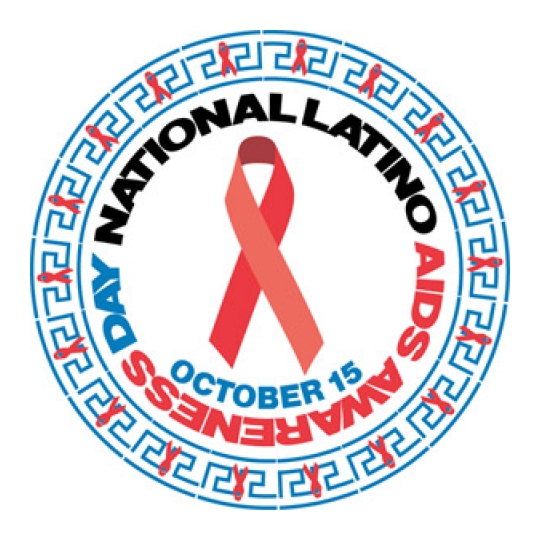Mark your calendar: Latino AIDS Awareness Day

Diagnoses and Prevalence of HIV Infection among Hispanics or Latinos (United States, 2008–2013)
(CDC) Hispanics or Latinos* represent about 17% of the total U.S. population and are disproportionately affected by human immunodeficiency virus (HIV) infection in the United States (1,2). In 2013, the rate of HIV diagnosis among Hispanics or Latinos (18.7) was nearly three times that of non-Hispanic whites (6.6) (1).
To better characterize HIV infection among Hispanics or Latinos aged ≥13 years in the United States, CDC analyzed data from the National HIV Surveillance System (NHSS). During 2008–2013, the rate of diagnoses of HIV infection among adult and adolescent Hispanics or Latinos decreased from 28.3 per 100,000 population in 2008 to 24.3 in 2013.
However, the number of diagnoses among males with infection attributed to male-to-male sexual contact increased 16%, from 6,141 in 2008 to 7,098 in 2013. In 2013, the rate of diagnosis of HIV infection among males (41.3) was six times the rate among females (6.8). During 2008–2013, behavioral risk factors for HIV infection among Hispanics or Latino differed among males and females and by place of birth.
During 2008–2013, a total of 276,633 adults and adolescents received a diagnosis of HIV infection in the 50 states and the District of Columbia. Of these, 57,406 (20.8%) were Hispanics or Latinos. A decline was observed in the rates of diagnosis per 100,000 population among Hispanic or Latino adults and adolescents, from 28.3 per 100,000 population in 2008 to 24.3 in 2013 (Table 1). During 2008–2013, the HIV diagnosis rate decreased among Hispanic or Latino males from 45.0 per 100,000 to 41 and among females from 10.1 per 100,000 to 6.8.
The rates remained stable or decreased among all age groups, with the largest decline among persons aged 35–44 years (39.6 per 100,000 to 29.5. Among Hispanic or Latino males with infection attributed to male-to-male sexual contact, the number of HIV diagnoses increased 16%, whereas diagnoses decreased in other transmission categories (Figure). Among Hispanic or Latino females, the estimated number of HIV diagnoses decreased in persons with infection attributed to injection drug use or heterosexual contact. The largest declines in males and females were observed among those with infection attributed to injection drug use (Table 1).
In 2013, the HIV diagnosis rate per 100,000 population among males (41.3) was more than six times the rate among females (6.8). By age group, the highest rate of HIV diagnosis (40.1) among Hispanics or Latinos occurred among persons aged 25–34 years. By transmission category, the largest number of HIV diagnoses occurred among males with infection attributed to male-to-male sexual contact (7,098 [82.8%]), and among females with infection attributed to heterosexual contact (1,194 [87.2%]) (Table 1). The estimated rate of diagnosis for 2013 ranged from 2.3 in Idaho to 90.1 in the District of Columbia (Table 2).
HIV transmission category among Hispanics or Latinos varied by place of birth (Table 3). Infection attributed to male-to-male sexual contact accounted for the majority of infection transmissions among males, irrespective of place of birth, ranging from a low of 53.6% among persons born in Puerto Rico to a high of 86.4% among persons born in South America. Hispanic or Latino males born in Puerto Rico had a higher proportion of HIV infections attributed to injection drug use (24.9%) than those born elsewhere, whereas Hispanic or Latino females born in the United States (21.2%) and Puerto Rico (20.5%) had a higher proportion of HIV infections attributed to injection drug use than those born elsewhere.
A smaller proportion of Hispanic or Latino males born in the United States (6.6%) had infection attributed to heterosexual contact compared with male Hispanics or Latinos born elsewhere. A smaller proportion of Hispanic or Latino females born in the United States (78.2%) and Puerto Rico (79.2%) had infection attributed to heterosexual contact compared with female Hispanics or Latinos born elsewhere.
At year-end 2012, an estimated 911,602 adults and adolescents were living with diagnosed HIV infection, and of these, 183,300 (20.1%) were Hispanics or Latinos (Table 2); the rate of persons living with HIV infection among Hispanics or Latinos was estimated at 458.8 per 100,000 population, and the estimated HIV prevalence ranged from 73.6 per 100,000 population in Montana to 1,947.5 in the District of Columbia (Table 2).
The disproportionate rate of HIV infection among Hispanics or Latinos and the disparities found within this population indicate that much work still needs to be done to reach Hispanics or Latinos at high risk for acquiring or transmitting HIV infection.
CDC and its partners are pursuing a high-impact prevention approach to maximize the effectiveness of current HIV prevention methods. Example activities include providing technical assistance to health departments and community-based organizations to deliver effective prevention interventions to Hispanics or Latinos, and supporting testing projects and campaigns that focus on Hispanics or Latinos, such as Reasons, which encourages HIV testing among Hispanic or Latino men who have sex with men.
CDC funds health departments across the United States and its territories for core HIV prevention activities, including activities for Hispanics or Latinos, and supports projects to optimize care outcomes, such as the Care and Prevention in the United States demonstration project, which promotes increased testing and linkage to, retention in, and reengagement in care for racial and ethnic minorities living with HIV (6).
1Division of HIV/AIDS Prevention, National Center for HIV/AIDS, Viral Hepatitis, STD, and TB Prevention, CDC; 2ICF International, Atlanta, Georgia. CDC: Kristen Mahle Gray, MPH1; Eduardo E Valverde, DrPH1; Tian Tang, MS2; Azfar-e-Alam Siddiqi, MD, PhD1; H. Irene Hall, PhD1
The Gayly - 10/11/2015 @ 11:44 a.m. CST





